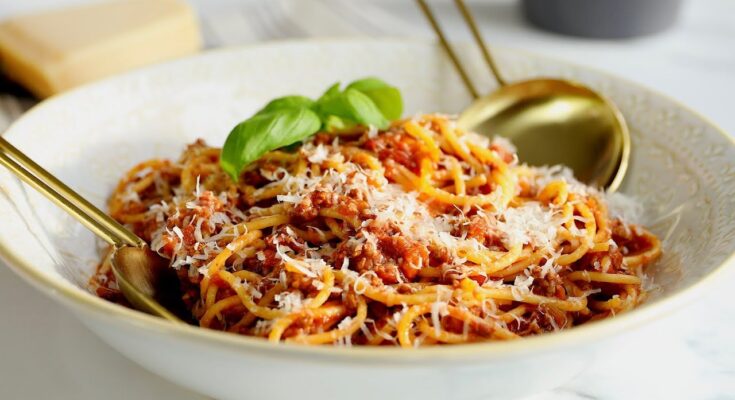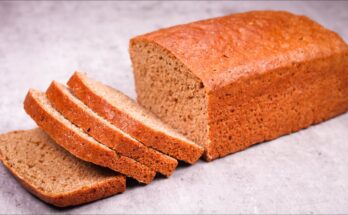Bolognese Recipe: Bolognese sauce is a rich and hearty Italian meat sauce that originated in Bologna, Italy. It’s a slow-cooked sauce made with ground meat, aromatic vegetables, and tomatoes, traditionally served over wide pasta like tagliatelle. While many people think of Bolognese as just another spaghetti sauce, it’s much thicker and creamier, offering complex flavors through a slow simmering process.
Although the traditional recipe calls for specific ingredients like beef and milk, modern variations exist to fit different tastes and diets. Whether you’re a beginner or a kitchen pro, this step-by-step guide will help you make an authentic, delicious Bolognese sauce.
Ingredients Needed for Authentic Bolognese Sauce
Essential Ingredients
- Ground beef or pork: Use a combination of both for depth of flavor.
- Carrots, onions, and celery: These form the base (soffritto) and give the sauce a sweet and aromatic foundation.
- Tomato paste and diced tomatoes: These add tanginess and a thick consistency to the sauce.
Optional Ingredients
- Wine (red or white): Adds richness and enhances the flavor of the sauce.
- Heavy cream or milk: Used traditionally to soften the acidity of the tomatoes.
- Herbs like bay leaves or thyme: Adds an earthy undertone.
Kitchen Equipment You Will Need
- Large pot or Dutch oven: For slow cooking the sauce evenly.
- Wooden spoon: To stir without scraping the pot.
- Cutting board and knife: For chopping vegetables.
Preparation Tips Before You Begin Cooking
- Chop your vegetables finely: This ensures the vegetables cook evenly and blend into the sauce.
- Use coarse ground meat: It helps maintain texture during the long cooking process.
- Simmer for hours: The key to great Bolognese is patience—slow cooking brings out the best flavors.
Step-by-Step Instructions for Making Bolognese Sauce
Step 1: Prepare Your Ingredients
Chop the carrots, onions, and celery into small pieces. Measure out your wine, tomatoes, and seasonings to have everything ready.
Step 2: Sauté the Vegetables (Soffritto)
In a large pot, heat some olive oil. Add the onions, carrots, and celery, cooking them over medium heat until soft and fragrant (about 8 minutes). This forms the aromatic base of your sauce.
Step 3: Brown the Meat
Add the ground beef and/or pork to the pot. Stir frequently, breaking the meat into small pieces as it browns. Make sure no pink remains before moving to the next step.
Step 4: Add Wine and Simmer
Pour the wine into the pot and scrape the bottom to release any browned bits (this is called deglazing). Let the wine simmer until it reduces by half, concentrating the flavor.
Step 5: Stir in Tomatoes and Paste
Add the diced tomatoes, tomato paste, and any herbs you’re using. Stir well to combine all ingredients.
Step 6: Slow Cooking the Sauce
Lower the heat to a simmer and let the sauce cook for 2-3 hours, stirring occasionally. The longer you simmer, the richer the flavors will become.
How to Serve Bolognese Sauce
Bolognese sauce is best served over wide, flat pasta like tagliatelle or pappardelle, which help capture the thick sauce. Top it with freshly grated Parmesan for an added burst of flavor.
Pro Tips for Making the Best Bolognese Sauce
- Don’t rush the simmering process: Time is what allows the flavors to develop.
- Use milk or cream: It mellows the acidity and adds richness.
- Taste and adjust seasoning along the way: This ensures the sauce is well-balanced.
Common Mistakes to Avoid
- Skipping the soffritto: This is essential for building flavor.
- Simmering too fast: The sauce needs low, slow cooking.
- Overcooking pasta: Serve pasta al dente to pair well with the sauce.
Variations of Bolognese Sauce to Try
- Vegetarian Bolognese: Use lentils or mushrooms instead of meat.
- Turkey Bolognese: A lighter version with ground turkey.
- Spicy Bolognese: Add chili flakes for heat.
Storing and Reheating Bolognese Sauce
Bolognese sauce stores well in both the fridge and freezer. In the fridge, it lasts up to 4 days, and in the freezer, it can stay fresh for 3 months. Reheat it gently over low heat to avoid burning.
Nutritional Value of Bolognese Sauce
The calorie count depends on the ingredients used, but on average, a serving provides:
- Calories: 400-500
- Protein: 25-30 grams
- Fat: 20-25 grams
For a healthier option, you can reduce the oil and substitute heavy cream with milk.
Pairing Suggestions with Bolognese Sauce
Pair your Bolognese with a glass of Chianti or Sangiovese for a perfect Italian meal. As a side dish, garlic bread or a crisp green salad works wonderfully.
FAQs about Bolognese Recipe
1. What is Bolognese sauce?
Bolognese is a traditional Italian meat-based sauce originating from Bologna, Italy. It is typically slow-cooked with ingredients like ground beef, onions, tomatoes, and a hint of wine, creating a rich, savory flavor.
2. How is Bolognese different from regular spaghetti sauce?
Unlike regular tomato-based spaghetti sauce, Bolognese features a thicker texture with more meat and often includes milk or cream for extra richness, giving it a distinct taste.
3. What type of pasta goes best with Bolognese?
Tagliatelle, fettuccine, or pappardelle are the traditional choices for Bolognese, as the wide noodles hold the sauce better. However, you can also serve it with spaghetti or penne.
4. Can Bolognese sauce be frozen?
Yes, Bolognese sauce freezes well. Store it in airtight containers for up to three months. Thaw overnight in the refrigerator before reheating for best results.
5. How long should you cook Bolognese sauce?
For the best flavor, Bolognese sauce should be simmered for at least two hours. Some traditional recipes suggest cooking it for even longer to enhance the richness.
6. Can you make Bolognese without wine?
Absolutely! While wine adds depth, you can substitute broth or water without compromising too much on flavor.
7. Is Bolognese gluten-free?
The sauce itself is typically gluten-free, but be sure to check any added ingredients, such as broth or stock. Pair it with gluten-free pasta to make the entire dish gluten-free.
8. How do you thicken Bolognese sauce?
If the sauce is too thin, you can simmer it uncovered to let some of the liquid evaporate. Alternatively, adding a bit of tomato paste will help thicken it and enhance the flavor.
Conclusion
Making Bolognese sauce from scratch is a rewarding experience. With the right ingredients and a little patience, you can create a delicious meal that transports you to Italy with every bite. Follow this guide, and you’ll have a perfect Bolognese to share with friends and family.
References
To support the information provided in this Bolognese recipe and offer readers additional insights, we’ve cited reputable sources below. These sources ensure the accuracy of the content and provide further reading for those seeking to master the art of Bolognese sauce:
- Serious Eats – Explore expert advice on crafting authentic Bolognese with step-by-step guidance.
- BBC Good Food – Discover traditional variations of Bolognese and creative serving ideas.
- The Kitchn – Learn pro tips for achieving rich, flavorful Bolognese through slow cooking techniques.
- Epicurious – Find additional recipes and practical tips to enhance your Bolognese experience.
These references not only validate the details shared but also offer deeper insights, helping you refine your cooking skills and create the perfect Bolognese sauce.



